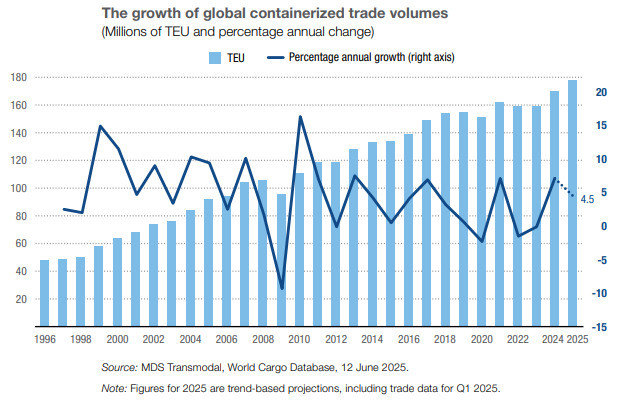Global container trade volume will grow at an annual rate of 4.5% in 2025, according to UNCTAD projections.
This will bring the total volume to 178 million 108,875 TEUs.
Container trade stands out for its logistical efficiency. It allows large volumes to be moved at reduced costs. In addition, it links global chains through strategic ports and promotes standardization. Thus, it drives the growth of international trade in manufactured goods.
In 2024, global container trade volumes showed steady growth. They rose by more than 6%. This was the second-highest rate among all cargo categories. In this way, the sector consolidated its role in the global market.
Container trade volume
Maersk (Denmark), Mediterranean Shipping Company-MSC (Switzerland), and CMA CGM (France) account for more than 45% of the global container transport market. This dominance reflects the high concentration of the sector and its key role in global shipping routes.
According to UNCTAD’s Maritime Transport 2025 report, container trade grew strongly in 2024. Sustained demand in the United States was key. Expansion into emerging markets, particularly in East Asia, Latin America, the Caribbean, the Indian subcontinent, and Africa, was also notable.
The standardized, sturdy container is essential to these chains. Its metal design facilitates loading, unloading, and transshipment between ships, trains, and trucks. This reduces time and costs. As a result, it has become a pillar of international trade.
Trend
In 2024, the main East-West trade routes showed solid growth. Transpacific flows to North America increased by 14.7%. Trade between East Asia and Europe grew by 10.2%. Transatlantic volumes between Europe and North America rose by 5.2%.
Distance-adjusted volumes also expanded strongly. They even exceeded the growth in container volume. The increase in TEU-miles reflected the continued diversion of vessels away from the Red Sea.
In particular, the route between East Asia and Europe faced changes. The passage around the Cape of Good Hope lengthened journeys by about 30%. This increased travel times and generated an estimated 11% spike in total TEU-mile demand.

